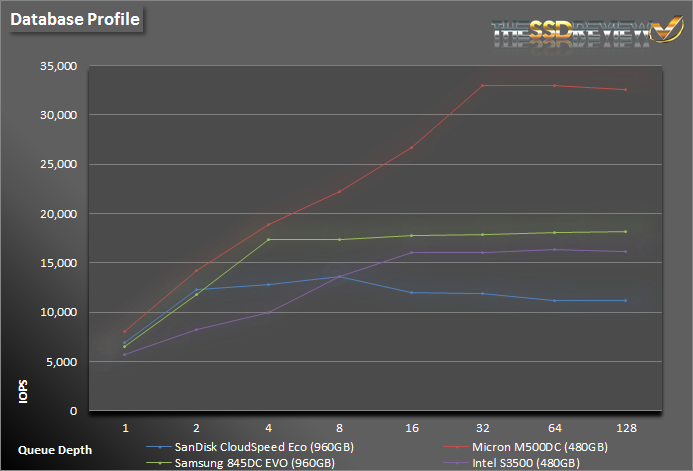SERVER PROFILES
While synthetic workloads do a great job of testing the underlying technology and reporting easy to understand results, they aren’t always indicative of how the drive will be used by the end user. Workloads that simulate enterprise environments try to bridge that gap without being overly complex.
The database profile is 8K transfers, and 67% percent of operations are reads.
In our database profile testing, the CloudSpeed Eco didn’t do too well when compared to the competition at higher QDs. Up until QD 8 it out performed the Intel S3500, however, from then on it degraded down to about 12.5K IOPS.
The fileserver profile is based on an 80% read/20% write mix. It’s made up of block sizes from 512 to 64K, each making up a different percentage of the access pattern. The pattern is: 512 bytes=10%, 1k=5%, 2k=5%, 4k=60%, 8k=2%, 16k=4%, 32k=4%, 64k=10%.
With the fileserver profile, the same general trend occurred. During this type of workload the competition outperformed the CloudSpeed Eco. We can see while the Samsung 845DC has similar performance numbers on its spec list, it is able to maintain higher performance throughout this test.
The webserver profile is similar to the fileserver profile, but has some additional 128K and 512K accesses thrown in for good measure. Additionally, the profile is 100% reads.
During the webserver profile, which is 100% reads we see much better performance out of the CloudSpeed Eco. It reaches up to about 23.5K IOPS at a QD of 32 with strong performance up until then. We can see that it is now able to best the Micron M500DC, however, the Intel S3500 and Samsung 845DC EVO still out perform it.
FINAL THOUGHTS
The SanDisk CloudSpeed Eco is an entry level enterprise SSD built for read-intensive applications. It isn’t the best performing SSD out, nor is it even at the top of its product line, but it does deliver good enough performance that is much greater than that of any HDD. It should prove to work well for its intended use cases such as photo sharing, web servers, media streaming, and VOD as well as cloud computing.
At its core is a Marvell 9189 controller and 19nm cMLC and through the use of their Guardian Technology Platform SanDisk has built in some great reliability into this SSD. It provides for important features such as power-loss protection and full data path protection as well as great durability through EverGuard, DataGuard, and FlashGuard Technologies. In testing we the CloudSpeed Eco was able to meet its performance specs of up to 450/400MB/s read/write and 80/14K IOPS read/write, however, it fell a bit short during our mixed workload and synthetic server tests.
With a warranty length of just 3 years, it is a bit short compared to most SSDs in this category which have 5-year warranties. In order to get a longer 5-year warranty you will have to step up to their CloudSpeed Ascend SSDs, or if you want better endurance and performance as well, their CloudSpeed Ultra SSDs, which provide for up to 3DWPD and up 25K IOPS write rather than 14K.
 At this time, being in such a competitive SSD segment, its price point is simply too high. When it comes to enterprise SSDs you either pay for endurance or performance. While being around $1 per GB was great when it was released back last year, to keep up with the competition it needs to go lower just others have. There are currently higher class SSDs delivering better performance at lower prices. Its 1DWPD rating is quite good, especially compared to the Samsung 845DC EVO, but it falls behind in terms of performance. Therefore, if looking into the CloudSpeed Eco be sure to check out the CloudSpeed Ascend as well. It just may offer you a much better value with its greater endurance rating.
At this time, being in such a competitive SSD segment, its price point is simply too high. When it comes to enterprise SSDs you either pay for endurance or performance. While being around $1 per GB was great when it was released back last year, to keep up with the competition it needs to go lower just others have. There are currently higher class SSDs delivering better performance at lower prices. Its 1DWPD rating is quite good, especially compared to the Samsung 845DC EVO, but it falls behind in terms of performance. Therefore, if looking into the CloudSpeed Eco be sure to check out the CloudSpeed Ascend as well. It just may offer you a much better value with its greater endurance rating.
 The SSD Review The Worlds Dedicated SSD Education and Review Resource |
The SSD Review The Worlds Dedicated SSD Education and Review Resource | 
